
- Software Engineer, Product
- Modern Technology stacks:
- So What is a Tech Stack?
- Frontend tech stack
- Backend tech stack
- How to choose/build a tech stack
- What is a CI/CD Pipeline?
- Software Business Analyst
- Node.js Express Back-end Overview
- Build React App With Java Backend
- Connecting React-Frontend and NodeJS/Express Backend Applications
- React-Frontend, Node.js/Express-Backend, MySQL Architecture
- React Frontend with a NodeJS/Express Backend SQL-Architecture
- TypeScript with a NodeJS/Express Backend
- Full-Stack React+Node.Js-express + Mongo-DB
- So What is git ?
- Git vs GitHub
- Big O Notation
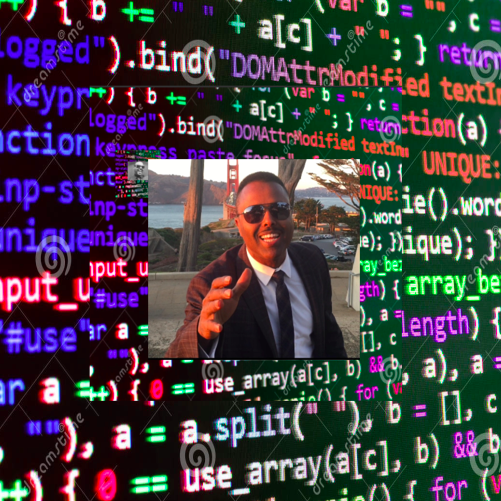


So What is a Tech Stack and How Do They Work?
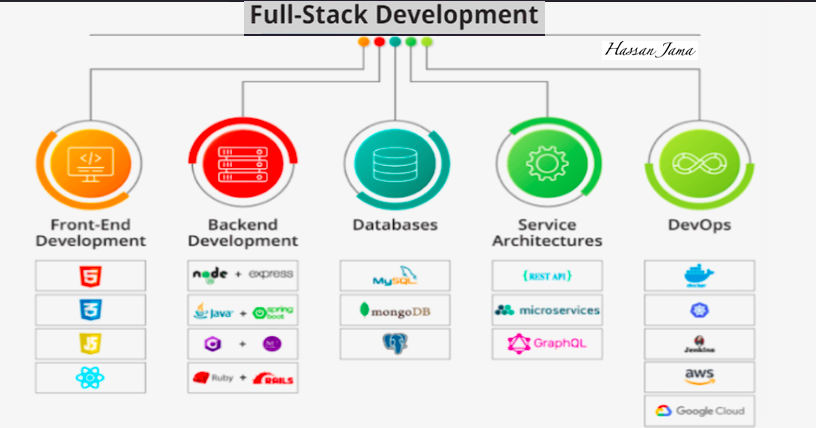
To understand the meaning of a tech stack, let's discuss the intent behind creating a web application.
The application you build should be fast and provide an interactive browsing experience to users. If users seek more information, the application must be able to quickly fetch and organize the information in an easy-to-view manner.
Further, as your application grows in popularity, it should scale well without adding any performance overhead to the application ecosystem.
For this to happen, you must have the right technologies and infrastructure that:
- Are cost-effective.
- Give a seamless front-end experience to users.
- Provide application developers with a fast and smooth development experience.
-Scale up and out when required.
The set of technologies that you choose to use to build an end-to-end web app, mobile application, IoT, or similar application forms the tech stack. The MERN stack is a trending technology stack example.
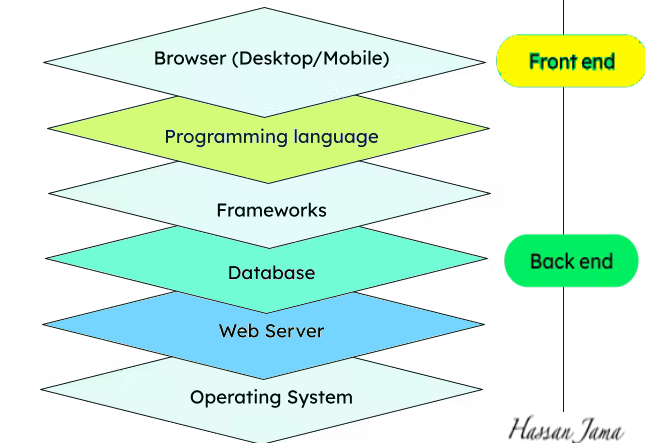 Example tech stack for a web application
Most tech stacks are a combination of front-end and back-end technologies like React.js ,HTML/CSS & Javascript (user interface), Java, Node.js & Express,Python (programming language), SQL/MySQ/MongoDB/Firebase/NoSQL(database), and Apache (server).
Example tech stack for a web application
Most tech stacks are a combination of front-end and back-end technologies like React.js ,HTML/CSS & Javascript (user interface), Java, Node.js & Express,Python (programming language), SQL/MySQ/MongoDB/Firebase/NoSQL(database), and Apache (server).
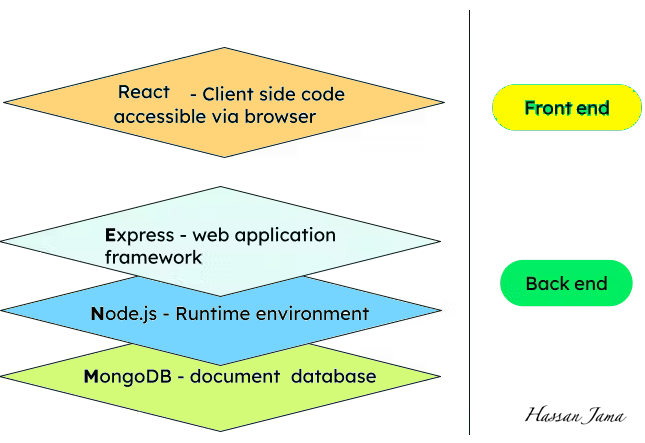 MERN stack components
In the above diagram, Node.js is the runtime for the web applications, React provides the user interface, Express is a web framework built over Node.js, and MongoDB is the data platform or data stack that has the ability to transform data into a more usable form.
The MERN and MEAN stacks are trending tech stacks for web development. Many full-stack developers find these tech stacks easy to learn and implement because of the common technology used throughout the stack: JavaScript. You can learn more about the MEAN stack in our detailed tutorial.
Another popular tech stack example is the LAMP, which stands for Linux, Apache, MySQL, and PHP.
In general, a tech stack can be a front-end tech stack, back-end tech stack, or a mix of both - i.e., a full stack.
MERN stack components
In the above diagram, Node.js is the runtime for the web applications, React provides the user interface, Express is a web framework built over Node.js, and MongoDB is the data platform or data stack that has the ability to transform data into a more usable form.
The MERN and MEAN stacks are trending tech stacks for web development. Many full-stack developers find these tech stacks easy to learn and implement because of the common technology used throughout the stack: JavaScript. You can learn more about the MEAN stack in our detailed tutorial.
Another popular tech stack example is the LAMP, which stands for Linux, Apache, MySQL, and PHP.
In general, a tech stack can be a front-end tech stack, back-end tech stack, or a mix of both - i.e., a full stack.
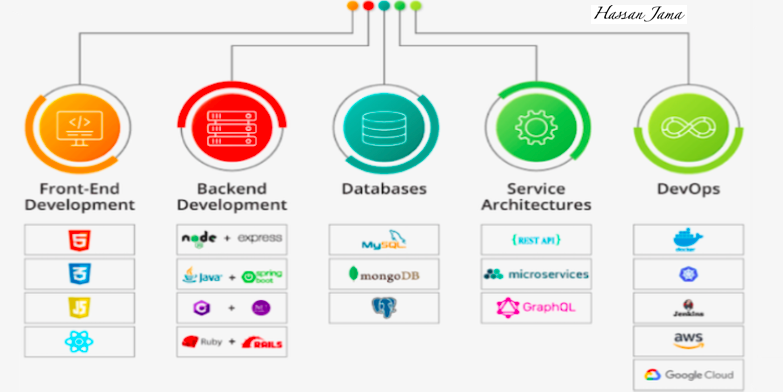

What is a tech stack?
A stack is an arrangement of "things" kept in order one over the other. Tech stacks are sets of technologies that are stacked together to build any application. Popularly known as a technology infrastructure or solutions stack, tech stacks have become essential for building web applications that are easy to maintain and scalable. Tech stacks determine the type of applications you can build, the level of customizations you can perform, and the resources you need to develop your application. For example, a web tech stack typically looks something like this: Example tech stack for a web application
Most tech stacks are a combination of front-end and back-end technologies like React.js ,HTML/CSS & Javascript (user interface), Java, Node.js & Express,Python (programming language), SQL/MySQ/MongoDB/Firebase/NoSQL(database), and Apache (server).
Example tech stack for a web application
Most tech stacks are a combination of front-end and back-end technologies like React.js ,HTML/CSS & Javascript (user interface), Java, Node.js & Express,Python (programming language), SQL/MySQ/MongoDB/Firebase/NoSQL(database), and Apache (server).
What is a modern tech stack?
Modern tech stacks have many more components because of the increase in the number of devices from which users can access applications and the huge volumes of events and data processing. They might include tools for containerization, performance monitoring, business intelligence, event processing, data lakes, cloud services, microservices, and analytics. You should choose the tech stacks you want to use based on your project needs and other factors, which we will discuss later in this article.What is an example of a tech stack?
One of the most popular and easiest examples of a technology stack is the MERN stack. MERN stands for MongoDB-Express-React-Node.js. You can replace React and use Angular, as in the MEAN stack, since React is becoming equally popular, especially for single-page web applications. MERN stack components
In the above diagram, Node.js is the runtime for the web applications, React provides the user interface, Express is a web framework built over Node.js, and MongoDB is the data platform or data stack that has the ability to transform data into a more usable form.
The MERN and MEAN stacks are trending tech stacks for web development. Many full-stack developers find these tech stacks easy to learn and implement because of the common technology used throughout the stack: JavaScript. You can learn more about the MEAN stack in our detailed tutorial.
Another popular tech stack example is the LAMP, which stands for Linux, Apache, MySQL, and PHP.
In general, a tech stack can be a front-end tech stack, back-end tech stack, or a mix of both - i.e., a full stack.
MERN stack components
In the above diagram, Node.js is the runtime for the web applications, React provides the user interface, Express is a web framework built over Node.js, and MongoDB is the data platform or data stack that has the ability to transform data into a more usable form.
The MERN and MEAN stacks are trending tech stacks for web development. Many full-stack developers find these tech stacks easy to learn and implement because of the common technology used throughout the stack: JavaScript. You can learn more about the MEAN stack in our detailed tutorial.
Another popular tech stack example is the LAMP, which stands for Linux, Apache, MySQL, and PHP.
In general, a tech stack can be a front-end tech stack, back-end tech stack, or a mix of both - i.e., a full stack.

Front-End Tech Stack

For most of the web applications, the choice of frontend tech stack remains similar. Modern web applications are based on HTML, CSS, JavaScript, TypeScript, or frameworks based on JS, like React, Vue,Angular and Express.

HTML
HTML (Hypertext Markup Language) defines the basic layout and structure of your pages. For example, the sections, bulleted points, and tables are created using HTML tags..CSS
All the styling that's applied to the web pages comes from CSS - for example, the Blue theme of the Jsxcode pages.JavaScript
The dynamic elements of the page come from the JavaScript code written by developers. For example, what happens when you hover your mouse over an image, or when you click on a submit, like, or comment button is decided by JavaScript events in the code. There are many other frameworks and libraries - like Bootstrap, React, Vue,Angular, and jQuery - that are built on JavaScript and provide additional functionalities and common use cases, making a developer's life much easier.Backend Tech Stack

Backend tech stacks (server-side) use different programming languages and tools to handle requests from the frontend and provide applications with data storage, processing, analytics, and more. The backend stack comprises many programming languages, including:
 MERN Stack is quickly becoming the most popular tech stack in the world as it offers a great mix of features and benefits. This open-source JavaScript Tech Stack is the best option if you want your app, software, site, or eCommerce store fast, secure, affordable, scalable, and efficient, so you can grow at your own pace without worrying about capacity constraints holding back growth potentials!
MERN Stack is quickly becoming the most popular tech stack in the world as it offers a great mix of features and benefits. This open-source JavaScript Tech Stack is the best option if you want your app, software, site, or eCommerce store fast, secure, affordable, scalable, and efficient, so you can grow at your own pace without worrying about capacity constraints holding back growth potentials!


PHP
PHP is used as a base for developing web applications.JavaScript
JavaScript (or JS for short) is used for handling user interactions, retrieving data, and processing requests.Laravel
Laravel is part of the PHP foundation and considered one of the most popular PHP frameworks.MySQL
MySQL is a database used for storing data and handling requests.Python
Python is a widely used programming language used for scripting purposes.Java
Java is an object-oriented programming language..C ++
C++ is used for developing high-level functionality and providing stability.Go
Go is a programming language developed by Google and is considered to be fast, reliable, and scalable.MERN Tech Stack
 MERN Stack is quickly becoming the most popular tech stack in the world as it offers a great mix of features and benefits. This open-source JavaScript Tech Stack is the best option if you want your app, software, site, or eCommerce store fast, secure, affordable, scalable, and efficient, so you can grow at your own pace without worrying about capacity constraints holding back growth potentials!
MERN Stack is quickly becoming the most popular tech stack in the world as it offers a great mix of features and benefits. This open-source JavaScript Tech Stack is the best option if you want your app, software, site, or eCommerce store fast, secure, affordable, scalable, and efficient, so you can grow at your own pace without worrying about capacity constraints holding back growth potentials!

React
A popular JavaScript library for building user interfaces.Node.js
An asynchronous event-driven JavaScript runtime perfect for building scalable real-time web applications. Combine these four technologies to build your next big idea. The MERN stack is a great place to start if you’re looking to get into web development.Express
A lightweight web framework helps you manage your application’s routes and middleware.MongoDB
A robust database that’s perfect for storing large amounts of data.How to choose the right tech stack for your application?

A tech stack encompasses various tools and technologies developers use to create applications. Such components include programming languages, storage systems, network protocols, and other devices. When working with multiple layers of the technology stack simultaneously, developers can more easily build robust applications that meet the needs of their end users.

 I have expert-level abilities in all operating systems platforms and functional analysis methods.
I am working on developing Front-end UI on React, HTML,CSS & Javascript, Java, Node.js & Express and SQL/MySQ/MongoDB/Firebase/NoSQL database Technologies
I have expert-level abilities in all operating systems platforms and functional analysis methods.
I am working on developing Front-end UI on React, HTML,CSS & Javascript, Java, Node.js & Express and SQL/MySQ/MongoDB/Firebase/NoSQL database Technologies
 My visionary skill translates into a big-picture solutions approach.
I have strong strengths in conceptualization and implementation of applications development within the architectural structure.
My visionary skill translates into a big-picture solutions approach.
I have strong strengths in conceptualization and implementation of applications development within the architectural structure.
Work Experience
Contributed to the design of a Mobile application on an application platform
Migration of company software from a single server to Amazon AWS
Responsible for rewrite of mobile application services and AI functionality in .Net and hosting within Azure Cloud
Focused on identifying and implementing process improvements during modernization efforts
I have worked as a L2/L3 for Teams Administrator + Support Engineer
Writing and updating technical documentation, including user manuals, system documentation, and training materials
Selenium automates browsers I created How to run Selenium tests on Chrome using ChromeDriver? step by step


What should I consider when choosing a tech stack?
There is no such thing as a uniformly effective tech stack. Different products and applications require different development tools. Time-tested technologies may not be right for the specific product or application your team is building, and new technologies might not have the needed functionality or support. Your focus should be on choosing technology that will improve the performance of your product or application — while allowing your engineering team to maintain the product's codebase and iterate faster. Take the following factors into consideration:Objectives and requirements
Start by considering your product vision and what functionality you will build to achieve that vision. For example, if your product or application processes large volumes of data, you need to prioritize technologies that process data quickly and cost-effectively. If you are building a stand-alone mobile app, your tech stack may be simpler - an iOS or Android app written in Objective-C/SWIFT or Java, for instance. It is important to evaluate technologies from both a strategic and technical viewpoint. If you choose a technology that does not truly meet your needs, you can end up with technical debt that may have been avoidable with better decision-making upfront.Team knowledge and upskilling
New frameworks or languages can appear to offer advantages, but your team may not have deep experience working with them. You will have to factor in the extra time it takes to learn the new technology. It can also be problematic if the new technology is untested and vulnerable to risk. But relying on outdated or ineffective technologies simply because team members have specific expertise can also compromise product quality.End-user experience and time to market
A customer's experience (and satisfaction) drives demand and keeps you in business. You want to identify technologies that provide a high-quality experience and also allow you to quickly launch product updates. Your ability to bring new experiences to customers can help generate faster feedback so you can improve the product.Cost
Consider the cost and overall value of the tech stack. Spending more money on ready-made tools may allow you to build your product more quickly but could come with tradeoffs if the tools are not as customizable as you need. Affordable technologies may have their own risks if they do not have the technical requirements you need. The right tech stack should minimize costs and bring more value in the long run because you are able to deliver a better product. Security Security is a significant factor for the business and your customers. But no tool is immune to security vulnerabilities — you have to discern the right balance of risks and benefits for your organization. A cutting-edge technology that allows you to ship quickly may be less battle-tested and more vulnerable. On the other hand, a battle-tested tool may better meet security needs but not allow you to iterate as quickly.Scalability
Can your tech stack scale both vertically and horizontally? Vertical scale allows you to add features on top of the product's core functionality. Horizontal scale allows you to handle a growing volume of users and activity. You may also want to look for third-party integrations that make it easier to add or extend features.Vendor support
If you anticipate needing vendor support or choosing enterprise tools, look for those that provide support. Can you reach the support team in the way you want — either by email, phone, or chat? If you ask a question, how quickly does their team respond? Many of the technologies in your tech stack will likely be open source. In that case, vendor support is not relevant. But you may want to explore whether the technology has a broad base of community support - an indication that the tool will continue to be maintained.The right tech stack for the organization
The process of choosing a tech stack can be fairly lengthy and overwhelming. It requires deep discussion with stakeholders, cross-functional planning, and practical hands-on experience. It can help to analyze what similar organizations or competitors are doing — without reflexively copying their stacks. A SWOT analysis can also be useful for evaluating your current stack or documenting a new technology's strengths, weaknesses, opportunities, and threats. Take time to thoroughly vet and plan a stack that works for your organization. What you select now will largely determine what you can build and the experiences you can provide. Ask plenty of questions to get at the essence of what the organization, engineering team, and customers need. My current Technical/Solutions Architect position has afforded me the opportunity to organize and develop the entire solutions process from start to finish. Excellent understanding of cross-browser compatibility allows me the ability to serve as a liaison between Enterprise Architects and Applications Developers allowing the delivery of exceptional applications that work across a variety of platforms and systems. With a BS Degree in Computer Science and ten years of progressively responsible Solutions Architect experience my extensive knowledge can offer the visionary and innovative approach needed in the role. I have expert-level abilities in all operating systems platforms and functional analysis methods.
I am working on developing Front-end UI on React, HTML,CSS & Javascript, Java, Node.js & Express and SQL/MySQ/MongoDB/Firebase/NoSQL database Technologies
I have expert-level abilities in all operating systems platforms and functional analysis methods.
I am working on developing Front-end UI on React, HTML,CSS & Javascript, Java, Node.js & Express and SQL/MySQ/MongoDB/Firebase/NoSQL database Technologies
 My visionary skill translates into a big-picture solutions approach.
I have strong strengths in conceptualization and implementation of applications development within the architectural structure.
My visionary skill translates into a big-picture solutions approach.
I have strong strengths in conceptualization and implementation of applications development within the architectural structure.
Work Experience
Contributed to the design of a Mobile application on an application platform
Migration of company software from a single server to Amazon AWS
Responsible for rewrite of mobile application services and AI functionality in .Net and hosting within Azure Cloud
Focused on identifying and implementing process improvements during modernization efforts
I have worked as a L2/L3 for Teams Administrator + Support Engineer
Writing and updating technical documentation, including user manuals, system documentation, and training materials
Selenium automates browsers I created How to run Selenium tests on Chrome using ChromeDriver? step by step
Full-Stack Engineer

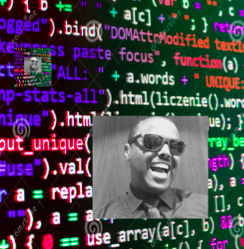
 Printer Friendly Version
Printer Friendly Version